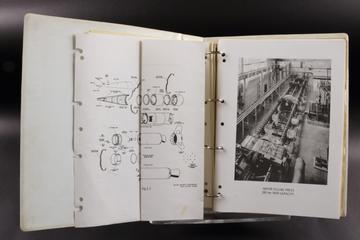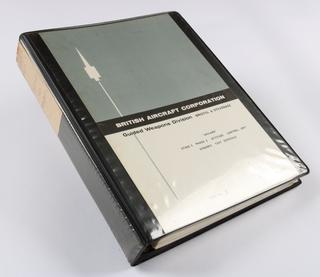
British Aircraft Corporation
The British Aircraft Corporation, often known simply as BAC, was formed on 18th July 1960 with the merger of the aviation interests of English Electric, Vickers-Armstrong and the Bristol Aeroplane Company. This was undertaken due to pressure from the British government, who had warned that it expected a consolidation of the aircraft industry, along with the guided weapons and engine industries, due to a decrease in the number of contracts it was going to offer. There was also some encouragement in the form of the contract for the TSR-2 aircraft, at the time the most advance aircraft design Britain had every produced, as well as the continuance of government research and development spending and a guarantee of aid for promising new types of civil aircraft.
The ownership of the new company would split between the original owners of the constituent divisions. As such both Vickers-Armstrong and English Electric received 40% of the shares and the remaining 20% was given to Bristol. Existing designs would be produced under these existing brands and the BAC name would initially only be added to group marketing material. The group also took over the design of the Bristol 223 supersonic airliner, which would be merged with a similar Sud Aviation design to produce Concorde. The head of research and development for the new company would be Sir Barnes Wallis who remained in this position until 1971.
During September 1960 the new company would acquire a 70% stake in Hunting Aircraft and at the same time would also be awarded the contract for the TSR-2.
In 1961 the first BAC design was produced, the BAC One-Eleven, and the company also established a subsidiary in the United States of America under the name British Aircraft Corporation (U.S.A.) Incorporated, which was aimed at promoting sales of the company’s aircraft and guided weapons.
During 1963 the group underwent a great deal of expansion and restructuring. It first acquired the guided weapons divisions of English Electric and Bristol Aircraft which it merged to form a new subsidiary, known as British Aircraft Corporation (Guided Weapons). This not only produced a number of guided missiles but also expanded to include electronics and space systems. In October BAC underwent a major change when it became a holding company and a new subsidiary was formed as British Aircraft Corporation (Operating) Limited. This took over the constituent aircraft manufacturers, Bristol, English Electric Aviation, Hunting Aircraft and Vickers-Armstrong Aircraft, which became divisions of the new company under the following names, BAC (Filton Division), BAC (Preston Division), BAC (Luton Division), and BAC (Weybridge Division). The guided weapons division would also be added into this group. The ownership of the holding company would remain with the three original companies.
During 1965 BAC would undergo a major loss when the British Government cancelled the TSR-2 project due to increasing costs. This was a major blow to the company but it was able to survive due to the success of its One-Eleven airliner.
In 1966 the group would form a joint company with Breguet under the name SEPECAT. This was established to develop a new strike aircraft for the British and French air forces and would eventually result in the Jaguar. The year would also see Rolls Royce acquire the Bristol Aeroplane Company so that it could amalgamate its engine business with that of Bristol Siddeley Engines. As a result, it would also acquire the 20% Bristol held in BAC. Although Rolls Royce initially stated that they did not wish to take over these shares they did not initially dispose of them and it wouldn’t be until the company went bankrupt in 1971 that Vickers and the General Electric Company, which had acquired English Electric in 1968, were able to purchase the 20% share. As well as this in September 1966 the Minister of Aviation, Tony Benn, announced that he believed that BAC and Hawker Siddeley should be merged into a single company. Despite this BAC’s success with the One-Eleven airliner and large defence contract with Saudi Arabia made it unlikely the parent companies would be willing to sell their shares and the proposal was soon dropped.
The British Aircraft Corporation would be a major opponent to the Airbus proposal during 1967, arguing instead in favour of its own design, the Three-Eleven. This design was initially ordered by British European Airways, but government pressure cancelled this and replaced it with the A300 design. As a result, BAC would not be involved in Airbus and it would be Hawker Siddeley that was the British representative, producing the wings for the new aircraft.
On 1st August 1968 British Aircraft Corporation Limited, the holding company of the group was renamed British Aircraft Corporation (Holdings) so that the operating subsidiary could be renamed British Aircraft Corporation. The newly named company would enjoy a major success when the first Concorde protype flew on 2nd March 1969, followed by the first British Concorde’s flight on 9th April the same year from BAC Filton. The design would eventually enter service with British Airways and Air France on 24th May 1976. The same year would also see the company forming a joint enterprise with Messerschmitt-Bölkow-Blohm, Fiat and Fokker. This was known as Panavia Aircraft GmBH and had been established to produce a multi role combat aircraft, which would become the Tornado.
On 29th April 1977, despite opposition from BAC and as a result of the Aircraft and Shipbuilding Industries Act, the British Aircraft Corporation was nationalised. Along with Hawker Siddeley Aviation, Hawker Siddeley Dynamics and Scottish Aviation it would be merged into the newly formed British Aerospace.


